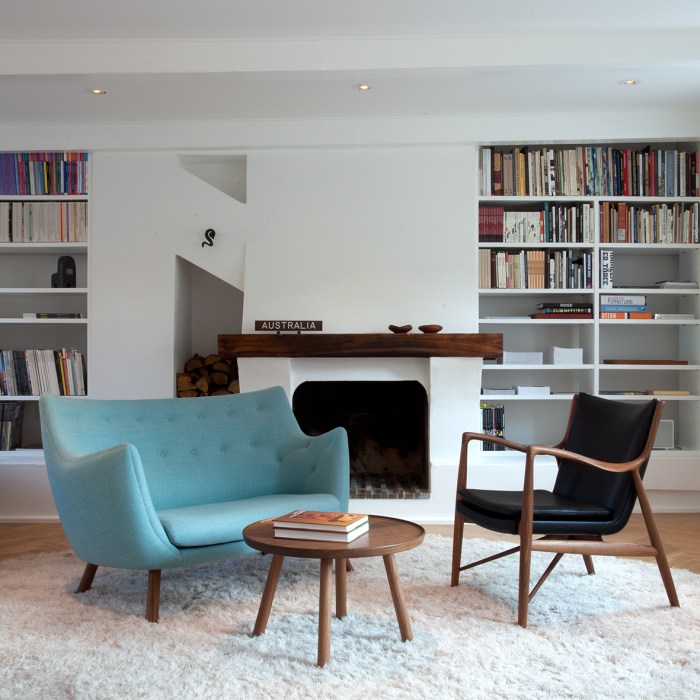Scandinavian furniture design embodies a unique blend of simplicity, functionality, and aesthetic appeal that has captivated the world with its timeless elegance. From iconic pieces to key influencers, this style continues to shape modern design trends.
Overview of Scandinavian Furniture Design

Scandinavian furniture design is known for its simplicity, minimalism, and functionality. The design style emphasizes clean lines, natural materials, and a focus on craftsmanship.
Scandinavian furniture design has its roots in the early 20th century, with a focus on creating affordable, functional, and aesthetically pleasing furniture for the masses. The movement gained popularity in the 1950s and 1960s, becoming synonymous with modern design.
Characteristics of Scandinavian Furniture Design
- Clean lines and simple forms
- Use of natural materials such as wood, leather, and metal
- Light color palette, often featuring whites, grays, and light woods
- Functionality and practicality in design
- Emphasis on craftsmanship and quality
Key Influencers and Pioneers in Scandinavian Furniture Design
Some of the key influencers and pioneers in Scandinavian furniture design include:
-
Alvar Aalto
: Known for his organic forms and innovative use of wood in furniture design.
-
Hans Wegner
: Renowned for his iconic chair designs, such as the Wishbone Chair and the Shell Chair.
-
Arne Jacobsen
: Famous for his functional and minimalist furniture designs, including the Egg Chair and the Series 7 Chair.
-
Verner Panton
: Known for his bold and futuristic furniture designs, often incorporating bright colors and unconventional shapes.
Elements of Scandinavian furniture design

Scandinavian furniture design is characterized by several key elements that set it apart from other styles. Let’s delve into the materials commonly used, the focus on simplicity and minimalism, as well as the emphasis on functionality and practicality.
Obtain a comprehensive document about the application of How to build an investment portfolio that is effective.
Materials commonly used in Scandinavian furniture
Scandinavian furniture often makes use of natural materials such as wood, particularly light woods like pine, beech, and ash. These materials not only add warmth to the design but also emphasize the connection to nature that is central to Scandinavian design principles.
Focus on simplicity and minimalism in design
The hallmark of Scandinavian furniture design is its clean lines, minimalist aesthetic, and uncluttered look. This emphasis on simplicity allows the beauty of the materials and the craftsmanship to shine through, creating a sense of calm and tranquility in the space.
Emphasis on functionality and practicality
Scandinavian furniture is designed with a focus on practicality and functionality. Each piece is thoughtfully crafted to serve a purpose, whether it’s a storage solution with hidden compartments or a chair that provides both comfort and style. This commitment to usability ensures that Scandinavian furniture is not only beautiful but also highly functional in everyday life.
Color palette and aesthetics
When it comes to Scandinavian furniture design, the color palette plays a crucial role in achieving the minimalist and cozy aesthetic that is characteristic of this style. The typical color palette used in Scandinavian furniture design includes neutral tones such as white, beige, grey, and light wood finishes. These colors are chosen to create a sense of openness, lightness, and simplicity in the space.
Importance of natural light
In Scandinavian design, natural light is considered essential as it helps to showcase the beauty of the furniture and the overall design of the space. Large windows, skylights, and light-colored walls are commonly incorporated to maximize the amount of natural light in a room. The abundance of natural light not only highlights the clean lines and sleek design of Scandinavian furniture but also creates a bright and airy atmosphere that contributes to the overall warmth and coziness of the space.
Aesthetics of Scandinavian design, Scandinavian furniture design
The aesthetics of Scandinavian design are focused on creating a sense of warmth and coziness in the home. This is achieved through the use of natural materials, such as wood and leather, as well as soft textiles like wool and fur. The clean lines, simple shapes, and functional design of Scandinavian furniture contribute to a minimalist yet inviting ambiance. The combination of these elements results in a space that feels welcoming, comfortable, and harmonious.
Iconic Scandinavian furniture pieces
Scandinavian furniture design has produced some truly iconic pieces that have stood the test of time and continue to influence modern design trends globally.
Arne Jacobsen’s Egg Chair
One of the most recognizable pieces of Scandinavian furniture design is Arne Jacobsen’s Egg Chair. Designed in 1958, this chair features a curved, egg-shaped silhouette that provides both comfort and style. Its iconic design has made it a symbol of mid-century modern design and a staple in interior decor around the world.
Hans Wegner’s Wishbone Chair
Another iconic piece is Hans Wegner’s Wishbone Chair, designed in 1949. This chair is known for its elegant and minimalist design, featuring a distinctive Y-shaped backrest that resembles a wishbone. The chair’s timeless appeal and craftsmanship have made it a classic in the world of furniture design.
Alvar Aalto’s Stool 60
Alvar Aalto’s Stool 60, created in 1933, is another iconic piece of Scandinavian design. This simple yet versatile stool is known for its bentwood legs and round seat, showcasing the beauty of natural materials and functional design. Its enduring popularity speaks to the lasting impact of Scandinavian design principles.
In conclusion, Scandinavian furniture design stands as a testament to the beauty of minimalism and practicality in creating warm, inviting spaces. With a rich history and iconic pieces, this design movement continues to inspire and influence the world of interior decor.
